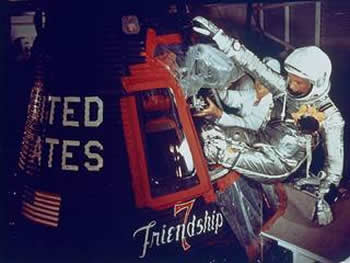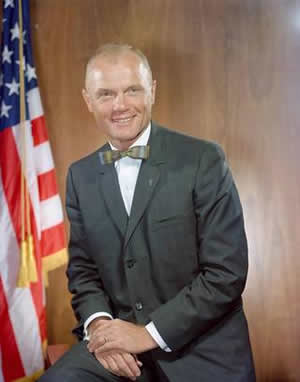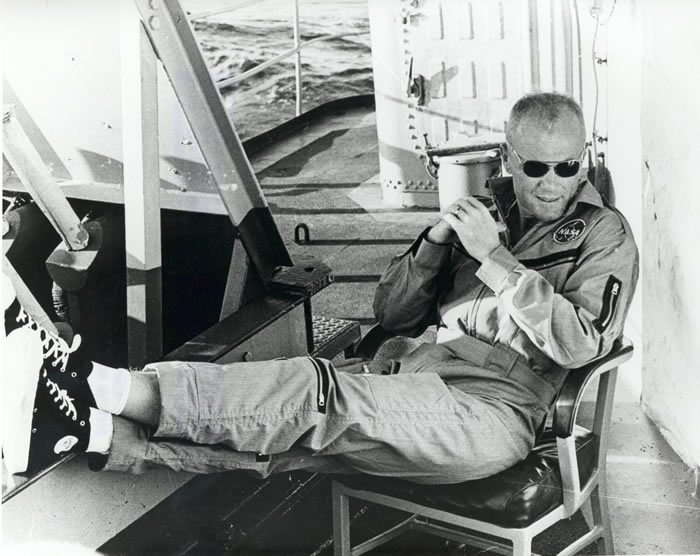US Senator John Glenn, who was also a former astronaut and the oldest human to venture into space, has died at the age of 95.
Glenn, who served four terms as a US senator, died at Ohio State University Wexner Medical Center in Columbus, on 8th December.
He was one of NASA’s original seven Mercury astronauts, and his flight on Friendship 7 on February 20th, 1962, showed the world that America was a serious contender in the space race with the Soviet Union. It also made Glenn an instant hero.
Glenn was also made iconic when his mission of almost nine days on the space shuttle that orbited the Earth in October 1998, made him the oldest human in space at 77. On the Discovery ship he participated in a series of tests on the aging process. The aging population was one focus of his work as a US senator.
Glenn was described as “humble, funny, and generous” by Trevor Brown, Dean of the John Glenn School of Public Affairs at Ohio State University, in a statement joined by the Glenn family. “Even after leaving public life, he loved to meet with citizens, school children in particular. He thrilled to music and had a weakness for chocolate.”
He will always be remembered as the first American to orbit the Earth during those tentative, challenging, daring days when humans were just beginning to venture beyond the atmosphere that had nurtured them since the species began.
The flight that Glenn participated in on Friendship 7 was in the end a national triumph, however problems were faced that could have led to disaster, including the failure of the automatic control system.
A scheduled 30 minute test to determine whether Glenn could fly the capsule manually became a matter of life and death when the automatic system went out at the end of the first orbit.
“I went to manual control and continued in that mode during the second and third orbits, and during re-entry,” Glenn recalled later. He had been confident he could do it.
“The malfunction just forced me to prove very rapidly what had been planned over a longer period of time.”
An even more serious problem was that the telemetry indicated the spacecraft’s heat shield was loose. It seemed possible that Glenn and the spacecraft would be incinerated on re-entry. It was a tense moment and the world held its breath.
Glenn left the retrorocket pack in place to steady the heat shield during re-entry. “It made for a very spectacular re-entry from where I was sitting,” he said. Big chunks of the burning material came flying by the window.
He wasn’t sure whether the flaming debris was the rocket pack or the heat shield breaking up. He told the interviewer: “Fortunately, it was the rocket pack – or I wouldn’t be answering these questions.”
John Herschel Glenn Jr. was born July 18th, 1921, in Cambridge, Ohio. He attended primary and secondary schools in New Concord, Ohio. He received a Bachelor of Science degree in engineering from Muskingum College in New Concord.
Over the years Glenn was awarded honorary doctoral degrees by nine different colleges or universities, Muskingum College was just one.
Glenn entered the Naval Aviation Cadet Program in March 1942. He graduated and was commissioned in the Marine Corps in 1943. After advanced training, he joined Marine Fighter Squadron 155 and spent a year flying F-4U fighters in the Marshall Islands. He flew 59 combat missions during World War II.
After the war, he was a member of Marine Fighter Squadron 218 on the North China patrol and served on Guam. From June 1948 to December 1950 he served as an instructor in advanced flight training at Corpus Christi, Texas. He then attended Amphibious Warfare Training at Quantico, Va.
 In Korea he flew 63 missions with Marine Fighter Squadron 311. As an exchange pilot with the Air Force Glenn flew 27 missions in the F-86 Sabre. In the last nine days of fighting in Korea, Glenn shot down three MiGs in combat along the Yalu River.
In Korea he flew 63 missions with Marine Fighter Squadron 311. As an exchange pilot with the Air Force Glenn flew 27 missions in the F-86 Sabre. In the last nine days of fighting in Korea, Glenn shot down three MiGs in combat along the Yalu River.
In July 1957, while he was project officer of the F-8U Crusader, he set a transcontinental speed record from Los Angeles to New York – 3 hours and 23 minutes. It was the first transcontinental flight to average supersonic speed.
Glenn accumulated nearly 9,000 hours of flying time, about 3,000 of it in jets.
After his selection as a Mercury astronaut, Glenn was assigned to the NASA Space Task Group at Langley, in April 1959. The Space Task Group was moved to Houston and became part of the NASA Manned Spacecraft Center (now Johnson Space Center in Houston) in 1962.
Before his 4 hour, 55 minute flight in the Friendship 7 capsule, Glenn had served as backup pilot for astronauts Alan Shepard, the first American in space who flew on May 5, 1961, and to Virgil ‘Gus’ Grissom, who followed Shepard on a suborbital flight of his own.
When astronauts were assigned to provide pilot input for the design and development of spacecraft, Glenn specialized in cockpit layout and control functioning, including some of the early designs for the Apollo Project.
Glenn resigned as an astronaut on January 16th, 1964. He was promoted to colonel in October 1964 and retired from the Marine Corps on January 1st, 1965.
He became an executive with Royal Crown International, but took an active part in Ohio politics and environmental protection efforts. He won his Senate seat in 1974, carrying all 88 counties of Ohio. He was re-elected in 1980 with the largest margin in Ohio history.
Ohio returned him to the Senate for a third term in 1986, again with a substantial majority. In 1992 he was elected again, becoming the first popularly elected senator from his state to win four consecutive terms.
During his last term he was the ranking member of both the Governmental Affairs Committee and the Subcommittee on Air/Land Forces in the Senate Armed Services Committee. He also served on the Select Committee on Intelligence and the Special Committee on Aging.
In 1998, Glenn flew on the STS-95 Discovery shuttle flight, a 9-day mission during which the crew supported a variety of research payloads including deployment of the Spartan solar-observing spacecraft, the Hubble Space Telescope Orbital Systems Test Platform, and Glenn’s investigations on space flight and the aging process.
More information: NASA.



Comments are closed, but trackbacks and pingbacks are open.